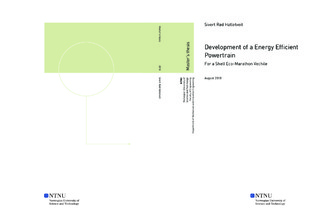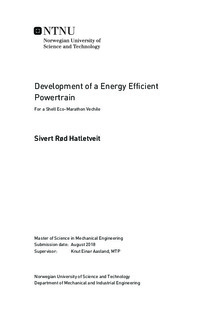| dc.contributor.advisor | Aasland, Knut Einar | |
| dc.contributor.author | Hatletveit, Sivert Rød | |
| dc.date.accessioned | 2019-09-11T09:11:11Z | |
| dc.date.created | 2018-08-10 | |
| dc.date.issued | 2018 | |
| dc.identifier | ntnudaim:19894 | |
| dc.identifier.uri | http://hdl.handle.net/11250/2615363 | |
| dc.description.abstract | This Master’s thesis is a continuation of author’s work in the pre-master thesis where an inertia motor/generator test bench were designed as a support for development of a new powertrain for a “Urban-Concept” battery-electric vehicle competing in Shell Eco-Marathon.
This test bench makes it possible to mount one of two symmetric powertrains where energy is transferred through a roller. By simulating the forces acting on a car the test bench supports powertrain development in the test phases in the following ways:
• Provide a more controlled test environment for development the power electronics and the mechanical sub systems of a powertrain
• Reduce risk of failure on track by providing an easy way to stress test and drive simulated laps
• Measure performance with a built-in torque transducer and Realtime tracking system
The team also set a goal to reduce 5 kilograms of weight while keeping the monocoque made by the DNV GL Fuel Fighter 2017 team. To reach this goal, the development of carbon fiber rims was included as a part of a new geared powertrain design with the support of regeneration of energy. This powertrain has a clutch system that synchronizes the gears speed and connects/disconnects the motor from the system to remove powertrain losses while rolling. The gearing happens with a 1- stage custom-made gear system with a custom-made internal spur ring gear with 375 teeth providing a possible reduction ratio of more than 20:1.
Some findings done on the new test bench by measurements done on the test rig was:
• Efficient acceleration and braking
• The effect of tare losses by having motor always connected at different speeds
• Efficiency plot for different speeds and motor torques for the powertrain as a whole
Other findings in the thesis includes the theoretical effect of having two different gearing ratios or overvolting the DC motors used in the car.
The tare losses measured gives reason to believe that a geared powertrain is more efficient as well as supporting efficient regeneration of energy. In addition, the new powertrain and carbon fiber rims were responsible for a weight reduction of over 7.2 kilograms where 4.7 kilograms of the savings were due the lightweight carbon fiber rims at 1.4 kilograms each.
The car’s performance was proven on track in Shell Eco-Marathon with a respectable 2nd place in the race and about 10% of recovery of energy through regeneration of power. In addition, the team took 2nd place in the communication off-track award. | en |
| dc.language | eng | |
| dc.publisher | NTNU | |
| dc.subject | Produktutvikling og produksjon, Produktutvikling | en |
| dc.title | Development of a Energy Efficient Powertrain - For a Shell Eco-Marathon Vechile | en |
| dc.type | Master thesis | en |
| dc.source.pagenumber | 204 | |
| dc.contributor.department | Norges teknisk-naturvitenskapelige universitet, Fakultet for ingeniørvitenskap,Institutt for maskinteknikk og produksjon | nb_NO |
| dc.date.embargoenddate | 10000-01-01 | |

